Panasonic SA-PM19E, SA-PM19EB, SA-PM19EG Service Manual

ORDER NO. MD0403117C2
CD Stereo System
SA-PM19E
SA-PM19EB
SA-PM19EG
Colour
(S)... Silver Type
(K)... Black Type (For E only)
Specification
n Amplifier Section |
|
Track system |
4 track, 2 channel |
|
RMS Power output |
|
Heads |
|
|
10% Total harmonic distortion |
|
Record/playback |
Solid permalloy head |
|
1 kHz, both channels driven |
|
Erasure |
Double gap ferrite head |
|
(Low channel) |
35 W per channel (6 Ω) |
Motor |
DC servo motor |
|
8 kHz, both channels driven |
|
Recording system |
AC bias 100 kHz |
|
(High channel) |
35 W per channel (6 Ω) |
Erasing system |
AC erase 100 kHz |
|
Total Bi-Amp power |
70 W per channel |
Tape speed |
4.8 cm/s |
|
Output Impedance |
|
Overall frequency response (+3 dB, -6 dB at Deck Out) |
||
Headphone |
16Ω - 32 Ω |
Normal (Type I) |
35 Hz - 14 kHz |
|
|
|
S/N RATIO |
45 dB (A weighted) |
|
n FM Tuner Section |
|
Wow and flutter |
0.10% (WRMS) |
|
Frequency range |
87.50 - 108.00 MHz (50 kHz |
Fast forward and rewind times |
Approx. 120 seconds with C-60 |
|
|
steps) |
|
cassette tape |
|
Sensitivity |
1.5 µV (IHF) |
|
|
|
S/N 26 dB |
1.5 µV |
n CD Section |
|
|
Antenna terminal(s) |
75 Ω (unbalanced) |
Disc |
|
|
|
|
CD, CD-R, CD-RW, MP3 |
8 cm/12 cm |
|
n AM Tuner Section |
|
Sampling frequency |
44.1 kHz |
|
Frequency range |
522 kHz - 1629 kHz (9 kHz |
Decoding |
16 bit linear |
|
|
steps) |
Pickup |
|
|
|
|
|
||
|
520 kHz - 1630 kHz (10 kHz |
Beam source/ Wavelength |
Semiconductor laser / 780 nm |
|
|
steps) |
|||
|
Number of channels |
Stereo |
||
Sensitivity |
|
|||
|
Frequency response |
20 Hz - 20 kHz (+1dB, -2dB) |
||
S/N 20 dB (at 999 kHz) |
560 µV/m |
|||
Wow and flutter |
Below measurable limit |
|||
|
|
|||
|
|
Digital filter |
8 fs |
|
n Cassette Deck Section
© 2004 Panasonic AVC Networks Singapore Pte. Ltd. All rights reserved. Unauthorized copying and distribution is a violation of law.

SA-PM19E / SA-PM19EB / SA-PM19EG
D/A converter |
MASH (1 bit DAC) |
MP3 |
|
Bit rate |
32kbps-320kbps |
Sampling frequency |
32kHz, 44.1kHz, 48kHz |
n General |
|
Power supply |
AC 230 V, 50 Hz (E, EG) |
|
AC 230 V - 240 V, 50 Hz (EB) |
Power consumption |
130 W |
Dimensions (W x H x D) |
179 x 250 x 383 mm |
Mass |
5.24 kg |
Power consumption in standby mode: |
0.8W |
n System: SC-PM19E-S |
Music Center: SA-PM19E-S |
|
Speaker: SB-PM19E-M |
n System: SC-PM19EB-S |
Music Center: SA-PM19EB-S |
|
Speaker: SB-PM19E-M |
n System: SC-PM19EG-S |
Music Center: SA-PM19EG-S |
|
Speaker: SB-PM19EG-M |
n System: SC-PM19E-K |
Music Center: SA-PM19E-S |
|
Speaker: SB-PM19P-K |
Notes: |
|
1.Specifications are subject to change without notice. Mass and dimensions are approximate.
2.Total harmonic distortion is measured by the digital spectrum analyzer.
3.The labels “HIGH” and “LOW” on the rear of the speakers refer to High frequency and Low frequency.
CONTENTS
|
Page |
|
1 |
Caution for AC Mains Lead |
4 |
2 |
Before Repair and Adjustment |
5 |
3 |
Protection Circuitry |
5 |
4 |
Handling the Lead-free Solder |
6 |
|
4.1. About lead free solder (PbF) |
6 |
5 |
Precaution of Laser Diode |
7 |
6 |
Handling Precautions For Traverse Deck |
8 |
7 |
Accessories |
9 |
8 |
Operation Procedures |
10 |
9 |
Assembling and Disassembling |
11 |
|
9.1. Disassembly flow chart |
11 |
|
9.2. Disassembly of Side Panel L & R |
12 |
|
9.3. Disassembly of Top Cabinet |
12 |
|
9.4. Disassembly of Deck P.C.B. & Tape Eject P.C.B. |
12 |
|
9.5. Disassembly of Front Panel |
13 |
|
9.6. Disassembly of Panel P.C.B., Headphone P.C.B. and |
|
|
Switch P.C.B. |
13 |
|
9.7. Disassembly of Tact Switch P.C.B. |
14 |
|
9.8. Disassembly of Rear Panel |
14 |
|
9.9. Disassembly of Main P.C.B. |
14 |
|
9.10. Disassembly of Transformer P.C.B. |
15 |
|
9.11. Disassembly of Speaker Terminal P.C.B |
15 |
|
9.12. Disassembly of Power P.C.B |
15 |
|
9.13. Disassembly of CR16 Mechanism |
15 |
|
9.14. Checking Procedure for Each Major P.C.B. |
17 |
|
9.15. Procedure for Replacing Cassette Holder |
17 |
|
9.16. Procedure for Replacing Pinch Roller and Head Block |
|
|
(Cassette Mechanism Unit) |
18 |
|
9.17. Procedure for Replacing Motor, Capstan Belt A, Capstan |
|
|
Belt B, and Winding Belt (Cassette Mechanism Unit) |
19 |
|
Page |
9.18. Procedure for Replacing Parts on Mechanism PCB |
20 |
9.19. Replacement of CD traverse deck |
21 |
9.20. Replacement of optical pickup unit (CD mechanism) |
22 |
9.21. Replacement of a traverse gear A and a traverse gear B |
|
|
23 |
9.22. Procedure for removing CD loading mechanism |
24 |
9.23. CR16 mechanism disassembly procedure |
24 |
9.24. CR16 MECHANISM ASSEMBLY PROCEDURE |
31 |
9.25. Disassembly of traverse mechanism |
43 |
9.26. Handling of cassette tape jam |
44 |
10 Service Positions |
45 |
10.1. Checking procedure |
45 |
10.2. Checking the major P.C.B. |
45 |
11 Self-Diagnostic Display Function |
46 |
11.1. Preparations |
46 |
11.2. Setting of the Self-Diagnostic Mode |
46 |
11.3. Restoring Normal Display |
46 |
11.4. Clearing Self-Diagnostic Memory |
46 |
11.5. Displaying Self-Diagnostic Results |
46 |
12 Procedure for Checking Operation of Individual Parts of |
|
Cassette Mechanism Unit |
49 |
12.1. Operation Check with Cassette Tape |
49 |
12.2. Operation Check without Cassette Tape |
49 |
13 Measurement And Adjustments |
51 |
13.1. Tuner/CD Sections |
51 |
13.2. Cassette Deck Section |
51 |
14 Block Diagram |
53 |
14.1. CD Servo Block |
53 |
14.2. Main Block |
55 |
15 Notes of Schematic Diagram |
60 |
2

SA-PM19E / SA-PM19EB / SA-PM19EG
16 Schematic Diagram |
61 |
|
17.7. Power P.C.B. |
84 |
16.1. CD Servo Circuit |
61 |
|
17.8. Transformer P.C.B. |
85 |
16.2. Main Circuit |
63 |
18 |
Wiring Connection Diagram |
86 |
16.3. Panel Circuit, Tact Switch Circuit, Switch Circuit and |
|
19 |
Illustration of IC , Transistors and Diodes |
88 |
Headphone Circuit |
67 |
20 |
Terminal Function of IC s |
89 |
16.4. Cassette Deck Circuit, Deck Mechanism Circuit and Tape |
|
20.1. IC701 (AN22004A-NF) IC HEAD AMP |
89 |
|
Eject Circuit |
69 |
|
20.2. IC702 (MN6627934CH) IC LSI |
89 |
16.5. Power Circuit |
71 |
|
20.3. IC703 (BA5948FPE2) IC 4CH DRIVE |
90 |
16.6. Transformer Circuit and Speaker Terminal Circuit |
74 |
|
20.4. IC302 (C2CBJF000016) MICRO PROCESSOR |
90 |
16.7. CD Loading Circuit |
75 |
21 |
Troubleshooting Flowchart (CD Section Circuit) |
92 |
17 Printed Circuit Board |
76 |
22 |
Parts Location and Replacement Parts List |
94 |
17.1. CD Servo P.C.B. (SIDE A and SIDE B) |
76 |
|
22.1. Deck Mechanism |
95 |
17.2. Main P.C.B. |
78 |
|
22.2. CD Loading Mechanism |
97 |
17.3. Panel P.C.B. and Tact Switch P.C.B. |
80 |
|
22.3. Cabinet |
102 |
17.4. Switch P.C.B., Headphone P.C.B. and Speaker Terminal |
|
22.4. Electrical Part List |
105 |
|
P.C.B. |
81 |
|
22.5. Packaging Materials & Accessories Parts List |
113 |
17.5. Deck P.C.B. and Tape Eject P.C.B. |
82 |
|
22.6. Packaging |
113 |
17.6. Deck Mechanism P.C.B. and CD Loading P.C.B. |
83 |
|
|
|
3
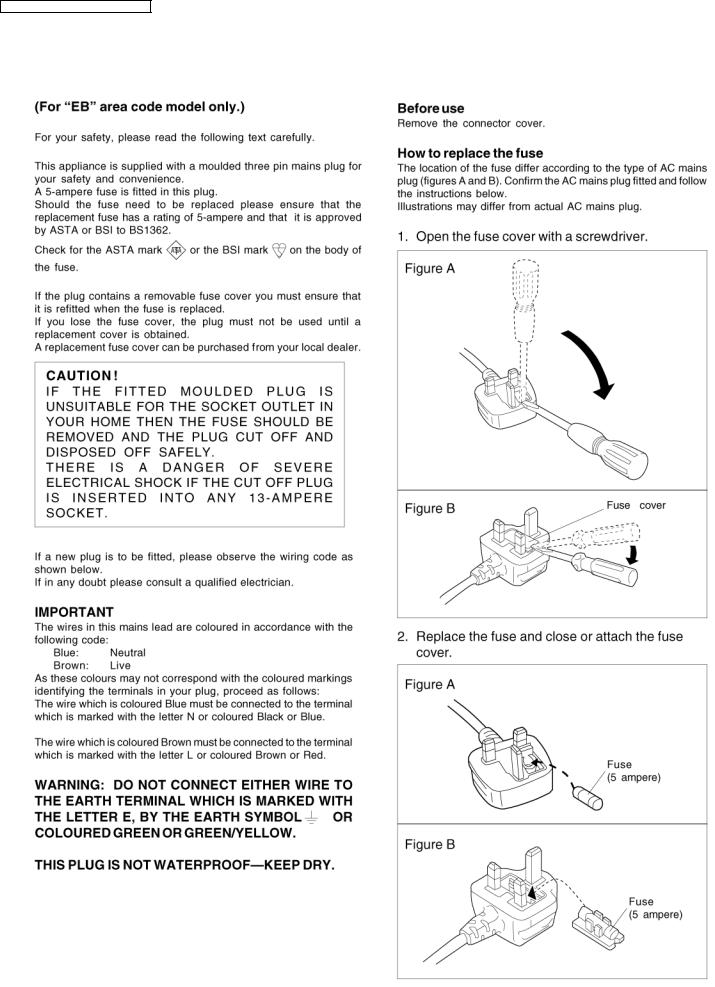
SA-PM19E / SA-PM19EB / SA-PM19EG
1 Caution for AC Mains Lead
4

SA-PM19E / SA-PM19EB / SA-PM19EG
2 Before Repair and Adjustment
Disconnect AC power, discharge Power Supply Capacitors C506, C507, C508, C584 & C311 through a 10Ω, 5W resistor to ground. DO NOT SHORT-CIRCUIT DIRECTLY (with a screwdriver blade, for instance), as this may destroy solid state devices.
After repairs are completed, restore power gradually using a variac, to avoid overcurrent.
·Current consumption at AC 230V, 50 Hz in NO SIGNAL mode should be ~300 mA. (For E, EG)
·Current consumption at AC 230V - 240V, 50 Hz in NO SIGNAL mode should be ~300 mA. (For EB)
3 Protection Circuitry
The protection circuitry may have operated if either of the following conditions are noticed:
·No sound is heard when the power is turned on.
·Sound stops during a performance.
The function of this circuitry is to prevent circuitry damage if, for example, the positive and negative speaker connection wires are "shorted", or if speaker systems with an impedance less than the indicated rated impedance of the amplifier are used.
If this occurs, follow the procedure outlines below:
1.Turn off the power.
2.Determine the cause of the problem and correct it.
3.Turn on the power once again after one minute. Note:
When the protection circuitry functions, the unit will not operate unless the power is first turned off and then on again.
5

SA-PM19E / SA-PM19EB / SA-PM19EG
4 Handling the Lead-free Solder
4.1.About lead free solder (PbF)
Distinction of PbF P.C.B.:
P.C.B.s (manufactured) using lead free solder will have a PbF stamp on the P.C.B.
Caution:
·Pb free solder has a higher melting point than standard solder; Typically the melting point is 50 - 70°F (30 - 40°C) higher. Please use a high temperature soldering iron. In case of soldering iron with temperature control, please set it to 700 ± 20°F (370 ± 10°C).
·Pb free solder will tend to splash when heated too high (about 1100°F/600°C).
·When soldering or unsoldering, please completely remove all of the solder on the pins or solder area, and be sure to heat the soldering points with the Pb free solder until it melts enough.
6

SA-PM19E / SA-PM19EB / SA-PM19EG
5 Precaution of Laser Diode
Caution :
This product utilizes a laser diode with the unit turned "ON", invisible laser radiation is emitted from the pick up lens. Wavelength : 780 nm
Maximum output radiation power from pick up : 100 µW/VDE
Laser radiation from pick up unit is safety level, but be sure the followings:
1.Do not disassemble the optical pick up unit, since radiation from exposed laser diode is dangerous.
2.Do not adjust the variable resistor on the pick up unit. It was already adjusted.
3.Do not look at the focus lens using optical instruments.
4.Recommend not to look at pick up lens for a long time.
ACHTUNG :
Dieses Produkt enthält eine Laserdiode. Im eingeschalteten Zustand wird unsichtbare Laserstrahlung von der Lasereinheit abgestrahlt.
Wellenlänge : 780nm
Maximale Strahlungsleistung der Lasereinheit :100µW/VDE
Die Strahlung an der Lasereinheit ist ungefährlich, wenn folgende Punkte beachtet werden:
1.Die Lasereinheit nicht zerlegen, da die Strahlung an der freigelegten Laserdiode gefährlich ist.
2.Den werkseitig justierten Einstellregler der Lasereinhit nicht verstellen.
3.Nicht mit optischen Instrumenten in die Fokussierlinse blicken.
4.Nicht über längere Zeit in die Fokussierlinse blicken.
ADVARSEL :
I dette a apparat anvendes laser.
CAUTION!
THIS PRODUCT UTILIZES A LASER.
USE OF CONTROLS OR ADJUSTMENTS OR PERFORMANCE OF PROCEDURES OTHER THAN THOSE SPECIFIED HEREIN MAY RESULT IN HAZARDOUS RADIATION EXPOSURE.
n Use of Caution Labels
7

SA-PM19E / SA-PM19EB / SA-PM19EG
6 Handling Precautions For Traverse Deck
The laser diode in the traverse deck (optical pickup) may break down due to potential difference caused by static electricity of clothes or human body.
So, be careful of electrostatic breakdown during repair of the traverse deck (optical pickup).
l Handling of CD traverse deck (optical pickup)
1.Do not subject the traverse deck (optical pickup) to static electricity as it is extremely sensitive to electrical shock.
2.The short land between the No.4 (LD) and No.5 (GND) pins on the flexible board (FFC) is shorted with a solder build-up to prevent damage to the laser diode (Fig 1).
3.Take care not to apply excessive stress to the flexible board (FPC board).
4.Do not turn the variable resistor (laser power adjustment). It has already been adjusted.
Fig 2
Caution when Replacing the Optical Pickup :
The traverse has a short point shorted with solder to protect the laser diode against electrostatics breakdown. Be sure to remove the solder from the short point before making connections.
Fig 1
l Grounding for electrostatic breakdown prevention
1.Human body grounding (Fig 2)
Use the anti-static wrist strap to discharge the static electricity from your body.
2.Work table grounding (Fig 2)
Put a conductive material (sheet) or steel sheet on the area where the traverse deck (optical pickup) is placed, and ground the sheet.
Caution :
The static electricity of your clothes will not be grounded through the wrist strap. So, take care not to let your clothes touch the traverse deck (optical pickup).
8

SA-PM19E / SA-PM19EB / SA-PM19EG
7 Accessories
Note : Refer to Packing Materials & Accessories for part number.
AC mains lead (For
EB only)
ACmains lead (For E & EG only)
FM indoor antenna
AM loop antenna
Remote control transmitter
Antenna plug adaptor (For EB only)
9
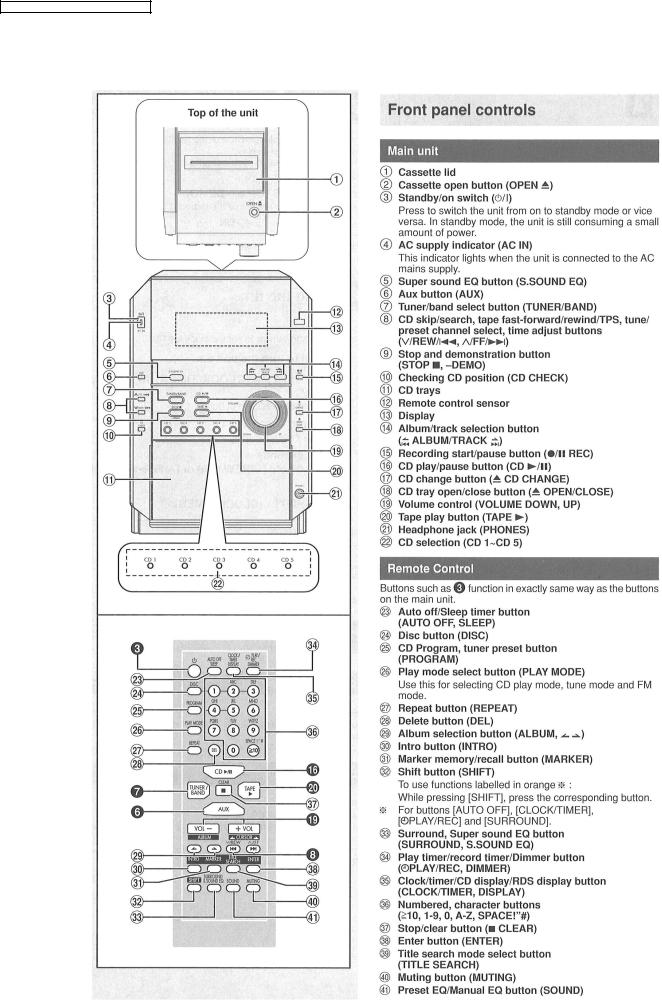
SA-PM19E / SA-PM19EB / SA-PM19EG
8 Operation Procedures
10
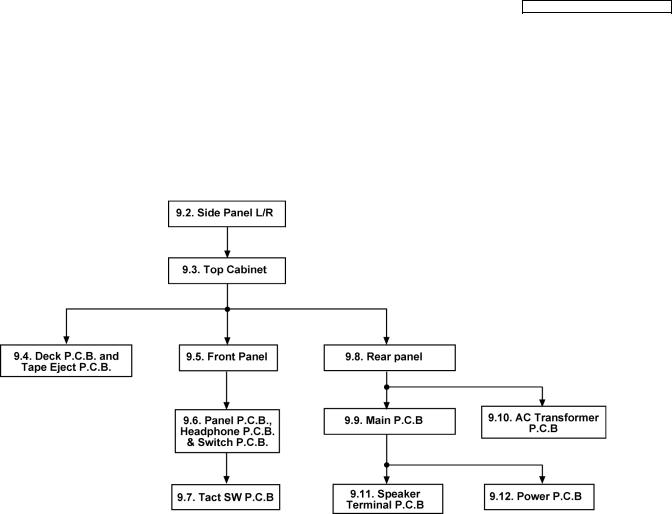
SA-PM19E / SA-PM19EB / SA-PM19EG
9 Assembling and Disassembling
9.1.Disassembly flow chart
The following chart is the procedure for disassembling the casing and inside parts for internal inspection when carrying out the servicing.
To assemble the unit, reverse the steps shown in the chart below.
11

SA-PM19E / SA-PM19EB / SA-PM19EG
9.2.Disassembly of Side Panel L & R
Step 1 : Remove all the screws. Step 2 : Remove the screw.
Step 3 : Remove the panel L as arrow shown.
Step 4 : Remove all the screws. Step 5 : Remove the screw.
Step 6 : Remove the panel R as arrow shown.
9.3.Disassembly of Top Cabinet
· Follow the (Step 1) - (Step 6) of Item 9.2.
Step 1 : Remove the screws.
Step 2 : Lift up the Top Cabinet and push backward as arrow shown, flip Top Cabinet sideway.
Step 3 : Detach the FFC Connector Board CN309.
9.4.Disassembly of Deck P.C.B. & Tape Eject P.C.B.
·Follow the (Step 1) - (Step 6) of Item 9.2.
·Follow the (Step 1) - (Step 3) of Item 9.3.
Step 1 : Remove the screw.
12
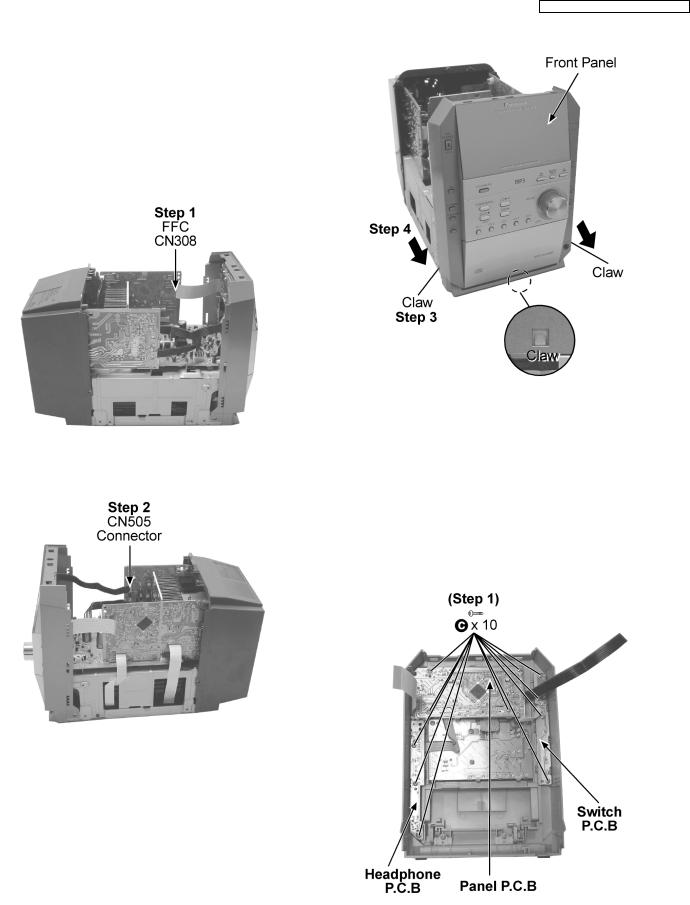
Step 2 : Release the clutch. Step 3 : Remove all the screws.
Step 4 : Press the lever as arrow shown and remove the Deck Mechanism.
9.5.Disassembly of Front Panel
·Follow the (Step 1) - (Step 6) of Item 9.2.
·Follow the (Step 1) - (Step 3) of Item 9.3.
Step 1 : Detach the FFC Board (CN308).
Step 2 : Detach the wire at CN505 Connector.
SA-PM19E / SA-PM19EB / SA-PM19EG
Step 3 : Release all the Claw.
Step 4 : Push the Front Panel as arrow shown.
9.6.Disassembly of Panel P.C.B., Headphone P.C.B. and Switch P.C.B.
·Follow the (Step 1) - (Step 6) of Item 9.2.
·Follow the (Step 1) - (Step 3) of Item 9.3.
·Follow the (Step 1) - (Step 4) of Item 9.5.
Step 1 : Remove all the screws.
13

SA-PM19E / SA-PM19EB / SA-PM19EG
Step 1 : Detach the wire at CN303 Connector.
Step 2 : Detach the CN603A Connector.
9.7.Disassembly of Tact Switch P.C.B.
·Follow the (Step 1) - (Step 6) of Item 9.2.
·Follow the (Step 1) - (Step 3) of Item 9.3.
·Follow the (Step 1) - (Step 4) of Item 9.5.
·Follow the (Step 1) - (Step 2) of Item 9.6.
Step 2 : Remove all the screws.
Step 3 : Release the Claws and remove Rear Panel as arrows shown.
9.9. Disassembly of Main P.C.B.
· Follow the (Step 1) - (Step 6) of Item 9.2.
· Follow the (Step 1) - (Step 3) of Item 9.3.
· Follow the (Step 1) - (Step 4) of Item 9.5.
· Follow the (Step 1) - (Step 3) of Item 9.8.
Step 1 : Remove all the screws.
Step 2 : Remove the Volume Knob.
9.8.Disassembly of Rear Panel
·Follow the (Step 1) - (Step 6) of Item 9.2.
·Follow the (Step 1) - (Step 3) of Item 9.3.
·Follow the (Step 1) - (Step 4) of Item 9.5.
14
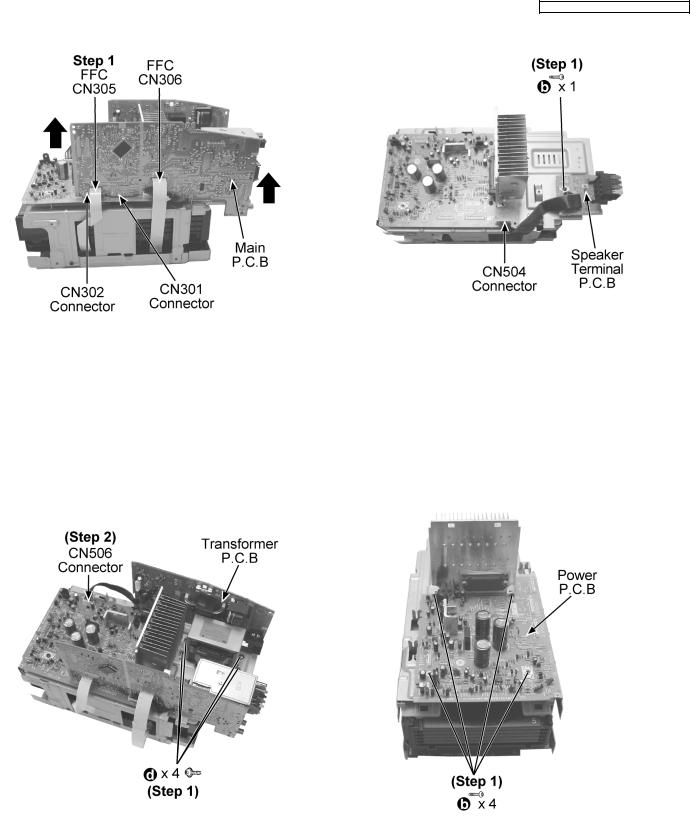
Step 1 : Remove the CN301, CN302 Connector and FFC CN305, CN306 .
Step 2 : Remove the Main P.C.B as arrow shown.
9.10.Disassembly of Transformer P.C.B.
·Follow the (Step 1) - (Step 6) of Item 9.2.
·Follow the (Step 1) - (Step 3) of Item 9.3.
·Follow the (Step 1) - (Step 4) of Item 9.5.
·Follow the (Step 1) - (Step 3) of Item 9.8.
Step 1 : Remove all the screws.
Step 2 : Detach the CN506 Connector.
9.11.Disassembly of Speaker Terminal P.C.B
·Follow the (Step 1) - (Step 6) of Item 9.2.
·Follow the (Step 1) - (Step 3) of Item 9.3.
·Follow the (Step 1) - (Step 4) of Item 9.5.
·Follow the (Step 1) - (Step 3) of Item 9.8.
·Follow the (Step 1) - (Step 2) of Item 9.9.
·Follow the (Step 1) - (Step 2) of Item 9.10.
SA-PM19E / SA-PM19EB / SA-PM19EG
Step 1 : Remove the screw and CN504 Connector.
9.12. Disassembly of Power P.C.B
·Follow the (Step 1) - (Step 6) of Item 9.2.
·Follow the (Step 1) - (Step 3) of Item 9.3.
·Follow the (Step 1) - (Step 4) of Item 9.5.
·Follow the (Step 1) - (Step 3) of Item 9.8.
·Follow the (Step 1) - (Step 2) of Item 9.9.
·Follow the (Step 1) - (Step 2) of Item 9.10.
·Follow the (Step 1) of Item 9.11.
Step 1 : Remove all the screws.
9.13.Disassembly of CR16 Mechanism
·Follow the (Step 1) - (Step 6) of Item 9.2.
·Follow the (Step 1) - (Step 3) of Item 9.3.
·Follow the (Step 1) - (Step 4) of Item 9.5.
·Follow the (Step 1) - (Step 3) of Item 9.8.
·Follow the (Step 1) - (Step 2) of Item 9.9.
·Follow the (Step 1) - (Step 2) of Item 9.10.
15
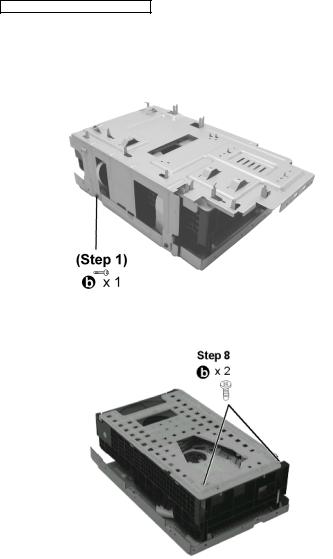
SA-PM19E / SA-PM19EB / SA-PM19EG
·Follow the (Step 1) of Item 9.11.
·Follow the (Step 1) of Item 9.12.
Step 1 : Remove the screw.
Step 2 : Remove 2 screws. Lift up the CD Mecha Unit.
16

SA-PM19E / SA-PM19EB / SA-PM19EG
9.14. Checking Procedure for Each Major P.C.B.
9.14.1. Replacement of the Power Amplifier IC
·Replacement of the Power Amplifier IC
·Follow the (Step 1) - (Step 6) of Item 9.2.
·Follow the (Step 1) - (Step 3) of Item 9.3.
·Follow the (Step 1) - (Step 4) of Item 9.5.
·Follow the (Step 1) - (Step 3) of Item 9.8.
·Follow the (Step 1) - (Step 2) of Item 9.9.
·Follow the (Step 1) - (Step 2) of Item 9.10.
·Follow the (Step 1) of Item 9.11.
·Follow the (Step 1) of Item 9.12.
Step 1 : Remove 2 screws fixed to the Power Amp I.C.
Step 2 : Unsolder the terminals of Power Amp IC, transistor and replace the component.
9.15. Procedure for Replacing Cassette Holder
·Follow the (Step 1) - (Step 6) of Item 9.2.
·Follow the (Step 1) - (Step 3) of Item 9.3.
Step 4 : Press the lever to open the cassette cover.
Step 5 : Remove the cassette mechanism unit.
Step 1 : Remove the screw. Step 2 : Release the clutch. Step 3 : Remove all the screws.
Step 6 : Remove the screw and damper gear.
17

SA-PM19E / SA-PM19EB / SA-PM19EG
Step 7 : Remove the cassette open spring. |
Step 8 : Pull out the cassette holder to the direction of the |
|
arrow shown. |
9.16.Procedure for Replacing Pinch Roller and Head Block (Cassette Mechanism Unit)
·Follow the (Step 1) - (Step 6) of Item 9.2.
·Follow the (Step 1) - (Step 3) of Item 9.3.
·Follow the (Step 1) - (Step 5) of Item 9.15.
18

SA-PM19E / SA-PM19EB / SA-PM19EG
9.17.Procedure for Replacing Motor, Capstan Belt A, Capstan Belt B, and Winding Belt (Cassette Mechanism Unit)
·Follow the (Step 1) - (Step 6) of Item 9.2.
·Follow the (Step 1) - (Step 3) of Item 9.3.
·Follow the (Step 1) - (Step 5) of Item 9.15.
·Follow the (Step 1) - (Step 5) of Item 9.16.
19

SA-PM19E / SA-PM19EB / SA-PM19EG
9.18. Procedure for Replacing Parts on Mechanism PCB
·Follow the (Step 1) - (Step 6) of Item 9.2.
·Follow the (Step 1) - (Step 3) of Item 9.3.
·Follow the (Step 1) - (Step 5) of Item 9.15.
·Follow the (Step 1) - (Step 5) of Item 9.16.
20

SA-PM19E / SA-PM19EB / SA-PM19EG
9.19. Replacement of CD traverse deck
·Follow the (Step 1) - (Step 6) of Item 9.2.
·Follow the (Step 1) - (Step 3) of Item 9.3.
·Follow the (Step 1) - (Step 4) of Item 9.5.
·Follow the (Step 1) - (Step 3) of Item 9.8.
·Follow the (Step 1) of Item 9.9.
·Follow the (Step 1) - (Step 2) of Item 9.13.
21

SA-PM19E / SA-PM19EB / SA-PM19EG
9.20. Replacement of optical pickup unit (CD mechanism)
·Follow the (Step 1) - (Step 6) of Item 9.2.
·Follow the (Step 1) - (Step 3) of Item 9.3.
·Follow the (Step 1) - (Step 4) of Item 9.5.
·Follow the (Step 1) - (Step 3) of Item 9.8.
·Follow the (Step 1) of Item 9.9.
·Follow the (Step 1) - (Step 2) of Item 9.13.
·Follow the (Step 1) - (Step 2) of Item 9.19.
22
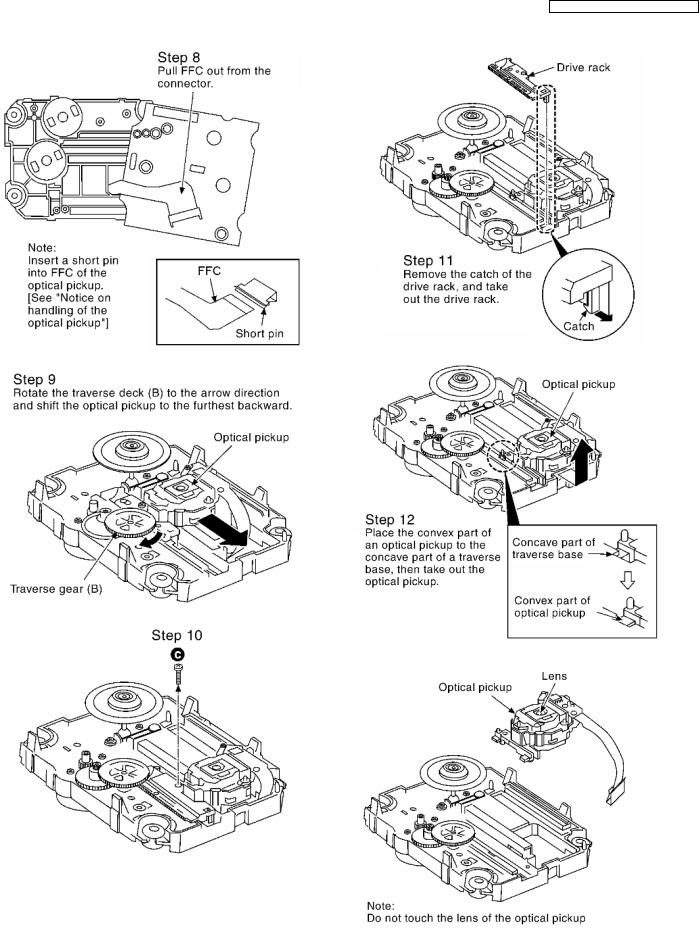
SA-PM19E / SA-PM19EB / SA-PM19EG
9.21. Replacement of a traverse gear A and a traverse gear B
·Follow the (Step 1) - (Step 6) of Item 9.2.
·Follow the (Step 1) - (Step 3) of Item 9.3.
·Follow the (Step 1) - (Step 4) of Item 9.5.
23

SA-PM19E / SA-PM19EB / SA-PM19EG
·Follow the (Step 1) - (Step 3) of Item 9.8.
·Follow the (Step 1) of Item 9.9.
·Follow the (Step 1) - (Step 2) of Item 9.13.
·Follow the (Step 1) - (Step 2) of Item 9.19.
·Follow the (Step 1) - (Step 12) of Item 9.20.
9.22. Procedure for removing CD loading mechanism
1.Turn off by pressing power SW in the body.
2.Unplug AC power cord after the indication of [GOOD-BYE], then disassemble the body.
3.Disassemble the body, and take out CD loading mechanism.
4.Perform disassembly according to the following procedure for disassembly.
9.23. CR16 mechanism disassembly procedure
9.23.1. Gear for servicing information |
procedures as follows. |
·This unit has a gear which used for checking items (open/close of disc tray, up/down operation of traverse unit by manually) when servicing. (For gear information, that is described on the items for disassembly procedures.)
·For preparation of gear (for servicing), perform the
·In case of re-servicing the same set, the “ gear for servicing” may be took off because it had been used. So, the “gear for servicing” must be stored.
1.Remove the gear attached to top cover of CD loading mechanism.
24

SA-PM19E / SA-PM19EB / SA-PM19EG
2. Insert the hexgonal wrench (2.5mm) into the gear.
9.23.2. Replacement for the disc tray
·Follow the (Step 1) - (Step 6) of Item 9.2.
·Follow the (Step 1) - (Step 3) of Item 9.3.
·Follow the (Step 1) - (Step 4) of Item 9.5.
·Follow the (Step 1) - (Step 3) of Item 9.8.
·Follow the (Step 1) of Item 9.9.
·Follow the (Step 1) - (Step 2) of Item 9.13.
25
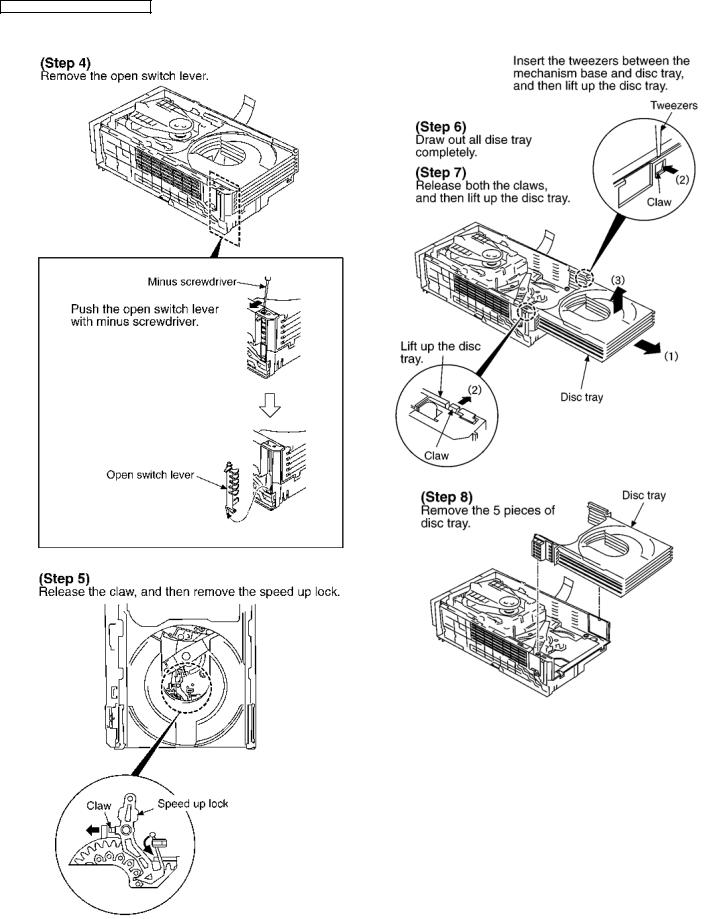
SA-PM19E / SA-PM19EB / SA-PM19EG
26

SA-PM19E / SA-PM19EB / SA-PM19EG
9.23.3. Replacement for the traverse deck
·Follow the (Step 1) - (Step 6) of Item 9.2.
·Follow the (Step 1) - (Step 3) of Item 9.3.
·Follow the (Step 1) - (Step 4) of Item 9.5.
·Follow the (Step 1) - (Step 3) of Item 9.8.
·Follow the (Step 1) of Item 9.9.
·Follow the (Step 1) - (Step 2) of Item 9.13.
·Follow the (Step 1) - (Step 10) of item 9.23.2.
27

SA-PM19E / SA-PM19EB / SA-PM19EG
9.23.4. Disassembly for CD loading unit
·Follow the (Step 1) - (Step 6) of Item 9.2.
·Follow the (Step 1) - (Step 3) of Item 9.3.
·Follow the (Step 1) - (Step 4) of Item 9.5.
·Follow the (Step 1) - (Step 3) of Item 9.8.
·Follow the (Step 1) of Item 9.9.
·Follow the (Step 1) - (Step 2) of Item 9.13.
·Follow the (Step 1) - (Step 10) of item 9.23.2.
·Follow the (Step 1) - (Step 4) of item 9.23.3.
28
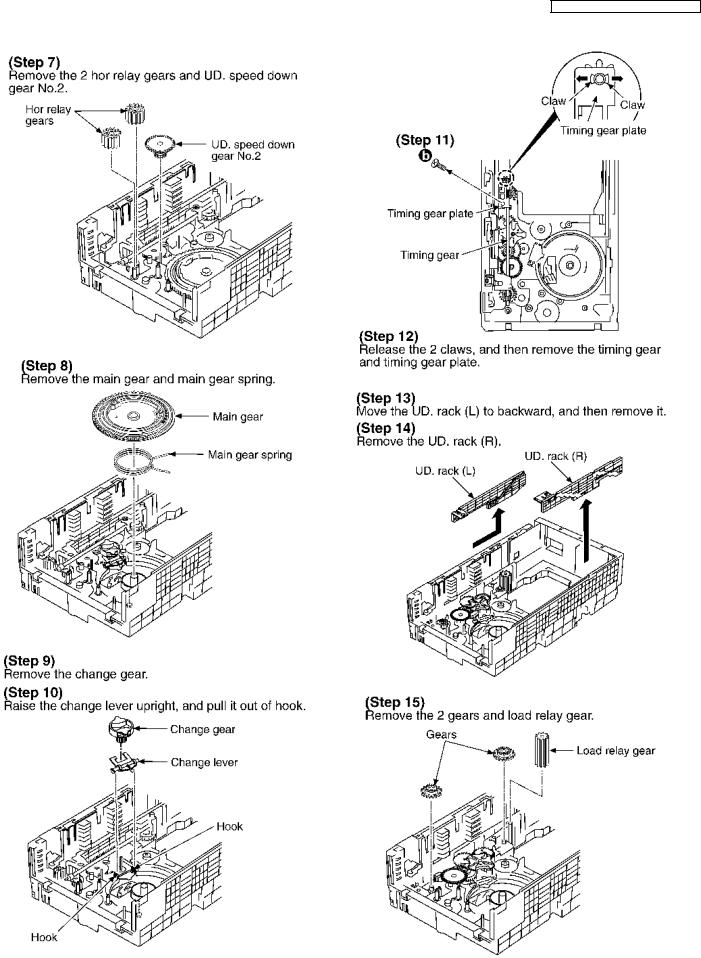
SA-PM19E / SA-PM19EB / SA-PM19EG
29

SA-PM19E / SA-PM19EB / SA-PM19EG
30
